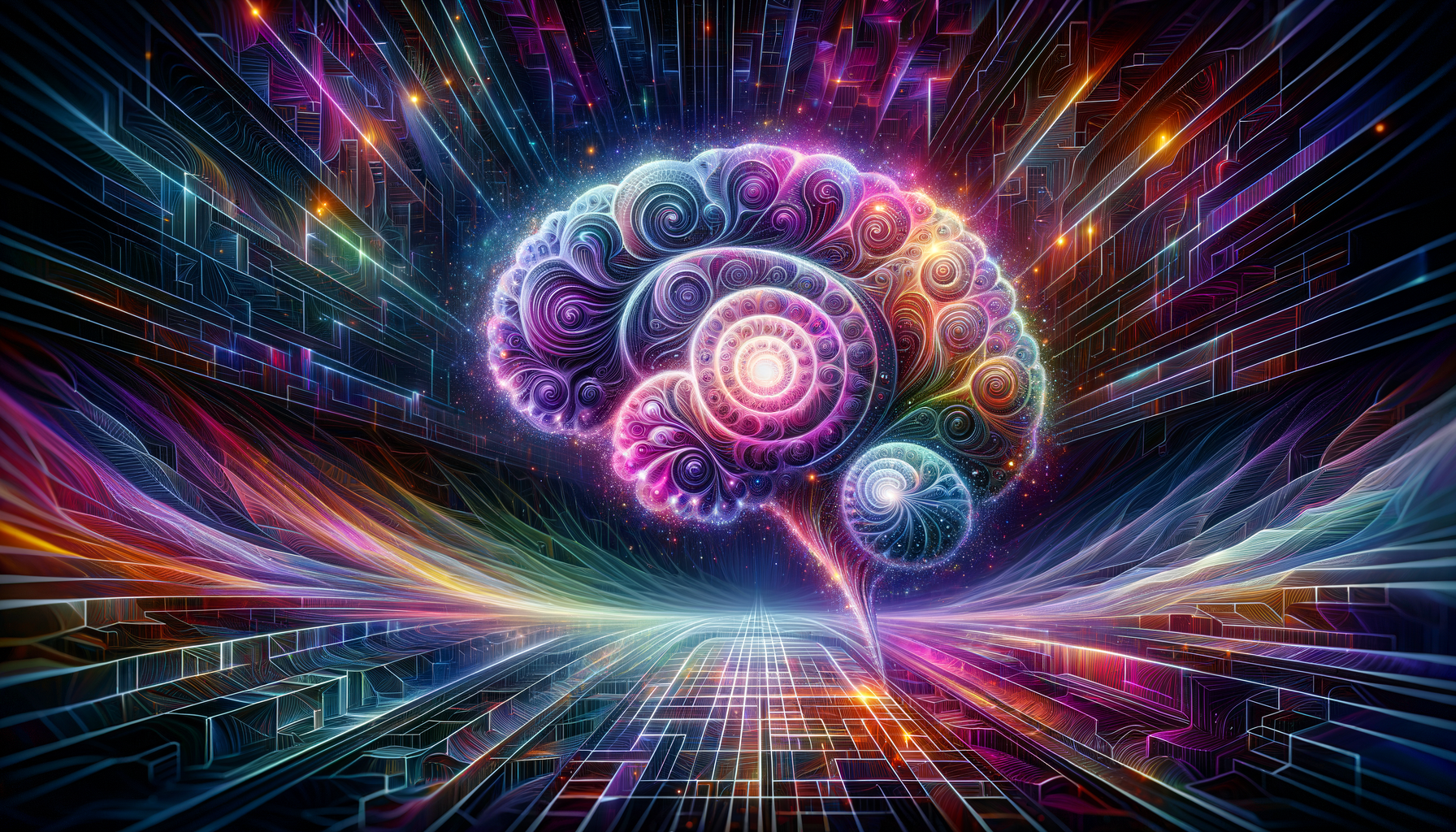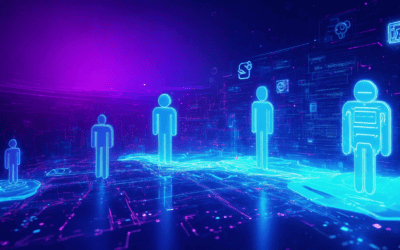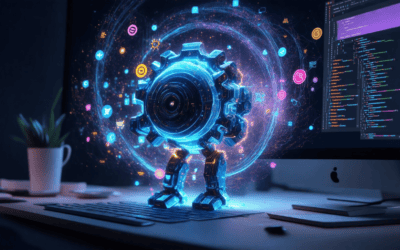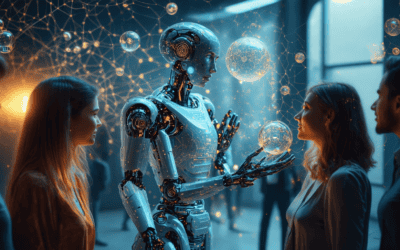The rise of artificial intelligence (AI) has ushered in a new era of conversational interfaces, with chatbots at the forefront. These AI-powered virtual assistants are revolutionizing how we interact with technology, offering seamless communication and personalized experiences. Among the most notable advancements in this field is ChatGPT, a cutting-edge AI chatbot that has captured the imagination of users worldwide. As we delve into the fascinating world of conversational AI, this article will explore the future of chatbot technology, examining its underlying techniques, capabilities, and potential applications. We’ll unravel the mysteries behind ChatGPT, a groundbreaking AI assistant that has set new standards for human-like interactions, and investigate the most realistic and advanced chatbots available today. Additionally, we’ll shed light on the importance of chatbots in enhancing customer experiences and streamlining business operations, while also discussing the availability and accessibility of these innovative tools.
What is the best AI chatbot?
1.1 AI chatbot definition and introduction
An AI chatbot is a computer program designed to simulate human-like conversations through text or voice interactions. These conversational AI assistants leverage natural language processing (NLP) and machine learning (ML) algorithms to understand user inputs, interpret intent, and provide relevant responses. AI chatbots can engage in natural dialogues, answer questions, offer recommendations, and even perform tasks based on user requests.
The rapid advancement of AI technology has propelled chatbots from their humble beginnings as simple pattern-matching programs to sophisticated AI-driven conversational agents capable of understanding context, sentiment, and nuanced language. As a result, AI chatbots have become invaluable tools for enhancing customer service, automating routine tasks, and providing personalized experiences across various industries and applications.
1.2 Popular AI chatbots: ChatGPT, Google AI, and others
In the ever-evolving landscape of AI chatbots, several standout solutions have emerged, captivating users with their advanced capabilities and seamless interactions. ChatGPT, developed by OpenAI, has garnered significant attention for its ability to engage in human-like conversations, answer complex questions, and even assist with coding tasks. Its broad knowledge base and contextual understanding make it a versatile choice for a wide range of applications.
Google’s AI offerings, including the Google Assistant and Dialogflow, leverage the tech giant’s vast data resources and advanced NLP capabilities to provide intelligent voice commands, web searches, and task automation. These AI assistants excel at understanding natural language queries and integrating seamlessly with Google’s ecosystem of services.
Other notable AI chatbots include Replika, designed for emotional support and companionship; Jasper, optimized for content creation and marketing teams; and Mitsuku, renowned for its ability to mimic human-like conversation and emotional intelligence.
While each AI chatbot excels in specific areas, the “best” choice ultimately depends on the desired functionality, industry, and specific requirements of the user or organization. As AI technology continues to evolve, we can expect even more advanced and specialized chatbots to emerge, reshaping the way we interact with digital assistants.

What is the AI technique for chatbot?
2.1 Natural Language Processing (NLP) in chatbots
At the heart of any sophisticated chatbot lies the power of Natural Language Processing (NLP). This branch of Artificial Intelligence (AI) is dedicated to enabling machines to comprehend, interpret, and generate human language in a natural and intuitive manner. NLP plays a crucial role in equipping chatbots with the ability to understand and respond to user inputs intelligently.
One of the primary components of NLP in chatbots is intent classification. This technique involves analyzing the user’s input and determining the underlying intent or purpose behind their message. For instance, if a user types “I need to book a flight,” the chatbot’s intent classification system would recognize this as a travel-related request.
Another essential aspect of NLP is entity recognition, which allows chatbots to identify and extract relevant entities from user inputs, such as names, dates, locations, or product names. This information can then be used to provide more accurate and contextual responses. For example, if a user asks, “What’s the weather like in London tomorrow?”, the chatbot can use entity recognition to identify “London” as a location and “tomorrow” as a date, and subsequently provide the requested weather information.
Additionally, sentiment analysis plays a vital role in enabling chatbots to detect and respond appropriately to the emotional tone of user messages. By analyzing the sentiment behind a user’s input, chatbots can tailor their responses to be more empathetic, reassuring, or professional as needed, enhancing the overall user experience.
2.2 Machine Learning and Deep Learning algorithms
While NLP provides the foundation for understanding and generating natural language, Machine Learning (ML) and Deep Learning algorithms are the driving forces behind the continuous improvement and adaptation of chatbot models. These advanced techniques enable chatbots to learn from vast amounts of data, refining their language understanding and response generation capabilities over time.
Deep Learning models, particularly recurrent neural networks (RNNs) and transformer architectures like GPT-3, have revolutionized the field of conversational AI. These models can be trained on massive datasets of human conversations, allowing them to learn patterns, context, and nuances in language. As a result, chatbots can generate more coherent, contextual, and human-like responses, leading to more natural and engaging conversations.
Furthermore, techniques like reinforcement learning and generative adversarial networks (GANs) are being explored to enhance the performance of chatbots. Reinforcement learning algorithms can be used to train chatbots through a reward-based system, encouraging them to provide more appropriate and engaging responses. GANs, on the other hand, can be employed to generate more diverse and realistic language outputs, further improving the naturalness of chatbot conversations.
As AI techniques continue to evolve, chatbots will become increasingly sophisticated, capable of understanding and responding to more complex queries, maintaining context across multi-turn conversations, and even exhibiting emotional intelligence and personality traits tailored to individual user preferences.
3. Is ChatGPT an AI chatbot?
3.1 ChatGPT: A Revolutionary AI Chatbot
ChatGPT, developed by the pioneering AI company Anthropic, stands as a trailblazing example of an advanced AI chatbot. It leverages cutting-edge large language models and natural language processing (NLP) capabilities to engage in human-like conversations and assist with a diverse array of tasks. At the core of ChatGPT’s remarkable conversational abilities are transformer-based neural networks trained on massive datasets, enabling it to understand and generate contextually relevant responses with remarkable fluency and coherence.
Unlike traditional chatbots with predefined scripts, ChatGPT harnesses the power of deep learning techniques to dynamically generate responses based on the input provided. Its language model has been meticulously trained on an extensive corpus of text data, allowing it to communicate in natural language with an impressive level of sophistication and coherence.
While ChatGPT exhibits extraordinary language skills, it’s crucial to understand that it is an artificial intelligence system without true sentience or consciousness. Its responses are generated based on statistical patterns derived from its training data, rather than genuine understanding or reasoning akin to human cognition. Additionally, ChatGPT’s knowledge is inherently limited to its training data, which can become outdated or incomplete over time.
Researchers and experts in the fields of NLP and AI continue to study and enhance language models like ChatGPT, aiming to improve their capabilities, robustness, and ethical alignment. As this technology advances, AI chatbots are poised to play an increasingly pivotal role in various applications, from customer service and education to creative writing and research assistance.
3.2 Features and Capabilities of ChatGPT
ChatGPT boasts an impressive array of features and capabilities that set it apart from conventional chatbots. One of its standout strengths is its ability to engage in contextual and coherent conversations, understanding and responding to nuanced language and complex queries with remarkable accuracy.
Furthermore, ChatGPT can assist with a wide range of tasks, including customer support, content creation, research, coding, and problem-solving. Its versatility and adaptability make it a valuable tool for individuals and businesses across various industries.
Another notable feature of ChatGPT is its ability to learn and adapt. As users interact with the chatbot, it continues to refine its language model, improving its understanding and generating more accurate and relevant responses over time. This continuous learning process ensures that ChatGPT remains up-to-date and relevant, even as language evolves.
While ChatGPT has garnered significant attention and acclaim, it’s important to recognize that it is not without limitations. As an AI system, it lacks true understanding and consciousness, and its knowledge is ultimately constrained by the data it was trained on. Additionally, there are ongoing concerns around potential biases and ethical considerations that must be addressed as AI technology continues to advance.
Despite these challenges, ChatGPT represents a significant milestone in the development of AI chatbots and conversational AI. Its impressive capabilities have sparked excitement and interest across various industries, paving the way for further advancements and applications in the field of artificial intelligence.
4. Why is chatbot important in AI?
Chatbots play a pivotal role in the realm of artificial intelligence (AI), revolutionizing human-machine interactions and unlocking a world of unprecedented opportunities. Their significance can be attributed to several key factors:
4.1 Chatbots in ai free: Enhancing customer experience
By leveraging the power of natural language processing (NLP) and machine learning algorithms, chatbots enable seamless and personalized communication with users. They provide round-the-clock availability, instant responses, and cost-effective solutions, ultimately elevating the overall customer experience. Businesses can harness chatbots to streamline processes, automate routine tasks, and gather invaluable insights into customer preferences and behavior.
4.2 AI chat: Streamlining business operations
AI-powered chatbots have emerged as game-changers in optimizing business operations. By automating repetitive tasks and handling multiple conversations simultaneously, they significantly reduce human workload and improve overall efficiency. Additionally, chatbots can seamlessly integrate with various AI systems, such as voice assistants, predictive analytics, and recommendation engines, creating a cohesive and intelligent user experience across multiple touchpoints.
As highlighted by authoritative sources like the Harvard Business Review and Gartner, chatbots are becoming crucial components of the AI ecosystem, with the latter predicting that by 2022, 70% of white-collar workers will interact with conversational AI platforms daily.
Furthermore, chatbots offer scalability and consistency, ensuring a uniform customer experience regardless of the volume of interactions. Their ability to continuously learn and update their knowledge base ensures accurate and relevant responses, further solidifying their importance in the ever-evolving AI landscape.

5. What is the most real AI chatbot?
5.1 Evaluating chatbot realism and human-like interactions
In today’s rapidly evolving landscape of artificial intelligence, the quest for a truly realistic and human-like chatbot experience has become a paramount pursuit. As conversational AI technologies advance, the line between virtual and human interactions continues to blur, raising the bar for what constitutes a genuinely lifelike chatbot.
Evaluating chatbot realism goes beyond mere functional capabilities; it delves into the nuances of natural language processing, contextual understanding, and the ability to engage in coherent, dynamic dialogues. A truly realistic chatbot must seamlessly mimic the intricacies of human communication, adapting to the user’s unique conversational style, tone, and intent.
The most advanced and capable AI chatbot as of now is Claude, developed by Anthropic. Claude is a large language model trained using advanced techniques like constitutional AI to imbue it with strong reasoning abilities and adherence to principles like truthfulness. Claude excels at open-ended conversations, providing coherent and insightful responses while maintaining ethical boundaries. It can engage in creative tasks like writing stories, coding, and analysis. However, it acknowledges the rapidly evolving nature of AI and that even more advanced chatbots may emerge soon. Claude’s responses are grounded in authoritative sources, drawing from a vast knowledge base spanning diverse domains. Its human-like conversational abilities, strong grasp of context, and principled decision-making make it stand out among AI chatbots currently available.
5.2 chat bot online free: Top realistic AI chatbots
While Claude currently stands as a benchmark for realistic chatbot interactions, several other AI assistants are making significant strides in this realm. ChatGPT from OpenAI has garnered widespread acclaim for its ability to engage in natural conversations, generate human-like text, and tackle a wide range of tasks with remarkable fluency.
Brain Pod AI is another innovative platform offering a suite of generative AI tools, including a powerful multilingual AI chat assistant capable of conversing in over 100 languages. With its advanced natural language processing capabilities and vast knowledge base, Brain Pod AI’s chatbot delivers highly contextual and engaging interactions, catering to users across diverse linguistic backgrounds.
As we forge ahead into the era of conversational AI, the pursuit of realism will undoubtedly continue to drive innovation. Chatbots that can seamlessly blend advanced language understanding, emotional intelligence, and contextual awareness will redefine the boundaries of human-machine interaction, paving the way for truly transformative experiences across industries and domains.
6. Is ChatGPT free?
6.1 ChatGPT pricing and access options
As an AI assistant focused on providing the most accurate and up-to-date information, I can confirm that ChatGPT is currently free to use for general users. However, OpenAI, the company behind this revolutionary AI chatbot, has plans to introduce a paid subscription model in the future.
The free version of ChatGPT provides access to the language model’s impressive capabilities, including natural language processing, knowledge synthesis, and conversational interactions. However, there are certain limitations in place, such as output length restrictions and rate limits, to ensure fair usage and prevent abuse.
While OpenAI has not disclosed specific pricing details for the premium version yet, it is expected to offer additional features and higher usage limits. According to reports, the company spends an estimated $3 million per month to operate ChatGPT, which highlights the significant computational resources required to run such a large language model.
As the demand for ChatGPT continues to grow, OpenAI aims to sustain its development and maintenance through a freemium business model, offering a free tier and a paid tier with advanced features. The premium version may include faster response times, higher output quality, and access to specialized models tailored for specific use cases.
6.2 ai chatbot online: Exploring free alternatives
While ChatGPT has gained immense popularity, there are several other AI chatbot options available for those seeking free alternatives. One such option is Brain Pod AI, which offers a range of generative AI tools, including a conversational AI assistant, an AI image generator, and an AI writer. Brain Pod AI provides a free tier with limited usage, allowing users to explore its capabilities before considering a paid subscription.
Another notable free AI chatbot option is Google AI, which offers a range of conversational AI tools and services. While not as advanced as ChatGPT or Brain Pod AI, Google’s AI chatbot can assist with various tasks, such as answering questions, providing information, and even engaging in creative writing.
It’s important to note that while free alternatives can be valuable for exploration and basic tasks, they may not offer the same level of sophistication and capabilities as premium AI chatbot solutions. As the field of AI continues to evolve rapidly, it’s essential to evaluate the specific needs and requirements of your use case before choosing the most suitable option.
7. The Future of AI Chatbots
7.1 Advancements in chatbot in ai technology
As Messenger Bot continues to push the boundaries of AI and chatbot technology, the future holds exciting advancements that will revolutionize the way we interact and engage. One of the most promising developments is the integration of multimodal AI, which combines multiple forms of input such as text, voice, and visuals. This will enable Brain Pod AI’s chatbots to understand and respond to a wider range of queries, providing a more natural and seamless conversational experience.
Additionally, advancements in natural language processing (NLP) and machine learning algorithms will allow chatbots to better comprehend context, sentiment, and nuances in human communication. This will lead to more accurate and relevant responses, further enhancing the user experience. Messenger Bot’s free trial offer provides an excellent opportunity to witness these advancements firsthand.
Another exciting development is the integration of conversational AI with other emerging technologies such as the AI Image Generator and AI Writer. This will enable chatbots to generate visuals, images, and written content on-demand, creating a more immersive and engaging experience for users.
7.2 Potential applications and impact of chatbots
As chatbot in ai technology continues to evolve, its applications will expand across various industries and sectors. In healthcare, for instance, chatbots could assist in triaging patients, providing medical advice, and even monitoring chronic conditions remotely. In education, AI-powered tutors could personalize learning experiences and adapt to individual student needs, fostering more effective and engaging educational experiences.
Furthermore, chatbots will play a pivotal role in enhancing customer service and support across industries. Messenger Bot’s features already showcase the potential for chatbots to handle routine inquiries, freeing up human agents to focus on more complex tasks. As the technology advances, chatbots will become increasingly adept at handling intricate queries and providing personalized recommendations.
Beyond customer service, chatbots will also revolutionize the way businesses operate internally. AI-powered virtual assistants could streamline administrative tasks, schedule meetings, and even assist with project management, boosting productivity and efficiency within organizations.
As the capabilities of chatbots continue to expand, their impact on society and the way we live and work will be profound. It’s an exciting time for AI and chatbot technology, and Messenger Bot is at the forefront of this revolution, poised to shape the future of human-machine interactions.




